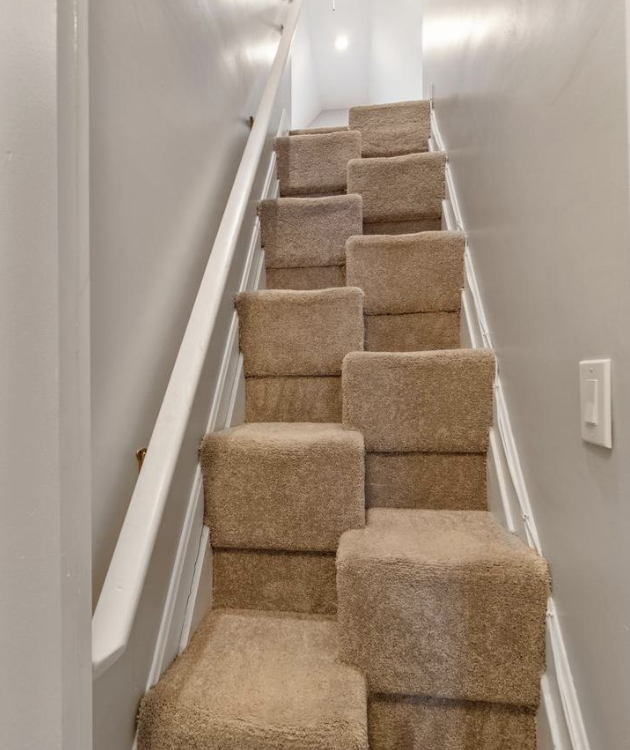Early in 2021, stories began circulating on various social media sites concerning several superstitiously spooky staircases photographed in old New-England homes. These staggered staircases had been documented before, but as trends do, they reemerged into the popular sphere of conversation when influencers began uploading videos of home tours and apartments that featured the objects along with captions like “We thought about making an offer on this home until we saw these stairs”. The internet quickly weighed in, mostly noting the awkward appearance of the steps and the perceived difficulty of navigating them; however, a theory was gaining steam and quickly becoming an urban legend. A specific photo and caption began circulating, along with an otherworldly explanation for the architectural feature.
What are “witches’ stairs”?
At first glance, witches’ stairs look like a staircase that has been cut in half and staggered so that each step is essentially a fraction of the size of a regular staircase. A more concise description can be attributed to Scott Schuttner, author of several books specializing on staircases. In an article by Reuters, Schuttner describes the characteristics of witches’ stairs, also known as Alternating Tread stairs. “On each side of an alternating-tread ladder stair, every other tread is omitted. [As a result] the distance between treads on a given side of an alternating tread-stair is actually twice the unit rise, which gives you more free tread area and therefore a safer stair in theory.”
Schuttner’s definition hints at the true origin and function of these so-called “witches’ stairs,” although the internet still had its turn to theorize first.
Where did the term witches’ stairs come from?
The origins of the term witches’ stairs can be largely traced back to a post shared on various social media hubs. The photo in question, credited to Daphne Card, is captioned, “Those are called Witches Stairs. Allegedly, witches can’t climb up them. You’ll occasionally find them in very, very old New England homes.” This theory gained steam, and the term “Witches’ Stairs” trended on several social media sites in the days following as users upload their own photos of these supposedly supernatural staircases.
One theory that arose on social media, though it has little basis in popular witch mythology, is that witches were unable to see their feet or that they were otherwise impaired from climbing or descending the staircase. The wealth of examples in New England homes lent credence to the theory because of its extensive history with witchcraft, including the famous Salem Witch Trials.
Are witches’ stairs real?
Evidence was gathering, and the theory that the stairs were built to ward off witches became popular amongst potential renters and home-buyers looking for a home with built-in spooky decor. Interestingly, google search results for “witches stairs,” which were virtually non-existent until the terminal months of 2020, spiked dramatically in February and March of 2021 when more posts featuring the bizarre feature began making the rounds on social media. This is evidence that the term itself as well as the interest in the witchy stairwells were possibly invented and maintained by social media itself.
Robin Briggs, a professor, and expert in the history of American Witchcraft, when questioned on the subject by Reuters, noted that there was no mention of witches’ stairs or staircases that could ward off witches in any historical or anecdotal data he’d come across. According to Briggs, the closest thing to a witches’ stair was the practice of “people building houses [burying] witch bottles under the threshold, and incorporating dead cats in fabric as protection against bewitchment.” All of this evidence, along with the anecdotal nature of the original claims, led to the theory that these witches’ stairs were used to ward off witches being thoroughly debunked. Alternate tread stairs in residential homes are likely a space-saving method, though they are usually only approved for locations with lofts or mezzanines.
What are witches’ stairs really for?
So if these stairs aren’t to ward off evil witches and provide magical protection over a dwelling, what are they for? For that, we can look to Mr. J.M. Lapeyre, who owns a patent on the alternating tread stair. Purportedly Lapeyre came up with the idea for an alternating tread staircase while watching a man struggle to descend a ladder with a toolbox in tow. Realizing the danger, he brainstormed a safer alternative. Flouring his feet, he practiced walking up and down a staircase until he determined the natural gait for people climbing and descending stairs. He designed the tread stair to alternate between a half-tread and a full-tread, making his design the most natural to use. While the stairs themselves were sparsely used and poorly documented before the Lapeyre stairs became commonplace, OSHA has approved them in compact workspaces as a safer alternative to a ship’s ladder while conserving more space than traditional stairs.
These staircases are mostly used in workplaces such as bars and factories to boost safety while conserving space and are rarely found in residential homes. The fact that they aren’t very accessible means you’re unlikely to see or use them in public spaces, and homes that feature them usually feature a loft or attic of some kind. In homes where they are used, they save space and provide a stylish utility. So while they may not ward off evil, these alternating tread “witches stairs” are still excellent at keeping you safe, even if it’s in a far more practical sense.
Josiah Thomas Turner is writer and musician based out of Washington Heights, New York. Turner received his undergraduate degree in Drama from the University of Wisconsin - Stevens Point before earning an M.F.A. in Playwriting from The University of Texas at Austin. Born and raised in Milwaukee, Wisconsin, Turner trained as a multi-instrumentalist from a young age and spent much of his early years creating and performing music. Josiah’s current interest include animation, video-games and French-Canadian prog-rock.



